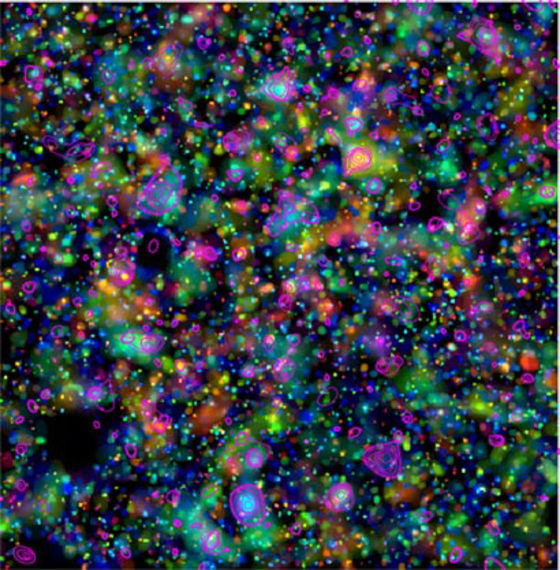To weigh the universe, scientists use two kinds of cosmic scales: one to measure all the regular matter out there, and another to deduce how much invisible dark matter remains hidden underneath.
These calculations have been taken further than ever before by a new study that tallied both types of mass in smaller and more distant groups of galaxies than any previous projects. The project found that these faraway galactic clusters have roughly the same proportion of dark matter to regular matter as the closer galaxy groups do.
The findings could help astronomers understand more about dark matter, as well as its even stranger sibling — dark energy.
Dark matter is a form of stuff that does not interact with light, so cannot be seen, but makes its presence felt by exerting a gravitational pull on normal matter.
Astronomers measure how much dark matter lies in galaxies by a fluke of physics called gravitational lensing. This phenomenon, predicted by Einstein's theory of general relativity, causes light to curve as it flies through space-time that has been dented by the gravity of large bodies of mass.
For example, groups of massive galaxies will gravitationally warp the space-time around them, forcing light to bend as it passes through, and causing them to look distorted when their light reaches our telescopes. Scientists can tell how much total mass there is by how much of this distortion occurs.
Next, researchers calculate how much normal matter is in a cluster of galaxies by looking at its X-ray light, since the light must be coming from only the regular stars and gas that make up the cluster.
Comparing these two calculations — the total matter to just the regular matter — gives a ratio astronomers call the mass-luminosity relation. So far, the mass-luminosity relation has been measured well for nearby, large galaxy clusters, but there has not been good enough X-ray data to probe farther or smaller, dimmer clusters of galaxies.
"We can map out the big cities, but no one's been able to map out the villages yet," said Alexie Leauthaud of the Lawrence Berkeley National Laboratory in Berkeley, Calif., leader of the new study.
New ranges
Astronomers used observations from the European Space Agency's XMM-Newton satellite and from NASA's Chandra satellite, as well as data from the Hubble Space Telescope's Cosmic Evolution Survey (COSMOS). These ultra-high resolution photos allowed the scientists to extend the mass-luminosity relation further than ever before.
With such dim objects, the gravitational lensing wasn't immediately apparent. So researchers used a statistical analysis to measure the orientation and shape of the galaxies to find small distortions due to so-called weak lensing.
They found that the same general ratio of dark matter to normal matter prevailed in these distant, small clusters as for nearby, larger clusters.
"We didn't know what to expect going down to lower masses or [farther distances], and we find this nice simple relationship," Leauthaud told SPACE.com. "Now the aim is to find out why we find this nice, simple relationship."
Dark energy enigma
The finding may help shed light on an even more bizarre aspect of the universe — dark energy. Dark energy is the name given to whatever mysterious force is causing the universe to accelerate as it expands.
"We want to try to understand the properties of dark energy," Leauthaud said. "One way to measure properties of dark energy is to measure the number of structures that have formed for a given amount of dark matter."
Dark energy basically works against gravity in a tug-of-war. While gravity constantly pulls mass inward, encouraging things to clump together and condense into smaller space, dark energy does the opposite. This force somehow pulls everything apart, causing everything in the universe to move away from everything else at ever-increasing speeds.
When mass clumps together enough to form galaxies, it means that gravity has won on those scales, helping things to stick together despite the pull of dark energy. So the more astronomers can measure when and how structures formed in the universe, the better they can understand just how far dark energy's pull reaches.
